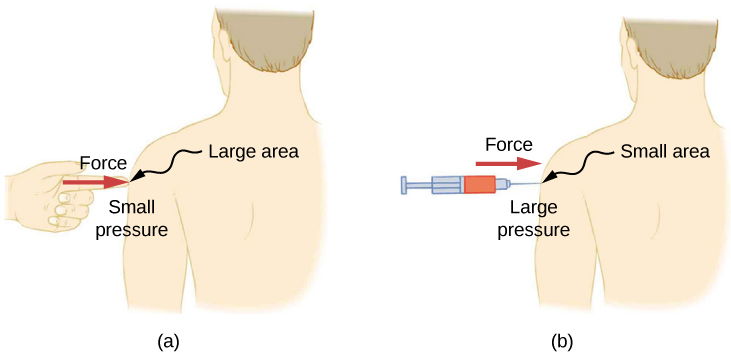| << Chapter < Page | Chapter >> Page > |
Pressure ( p ) is defined as the normal force F per unit area A over which the force is applied, or
To define the pressure at a specific point, the pressure is defined as the force dF exerted by a fluid over an infinitesimal element of area dA containing the point, resulting in .
A given force can have a significantly different effect, depending on the area over which the force is exerted. For instance, a force applied to an area of has a pressure that is 100 times as great as the same force applied to an area of That is why a sharp needle is able to poke through skin when a small force is exerted, but applying the same force with a finger does not puncture the skin ( [link] ).

Note that although force is a vector, pressure is a scalar. Pressure is a scalar quantity because it is defined to be proportional to the magnitude of the force acting perpendicular to the surface area. The SI unit for pressure is the pascal (Pa), named after the French mathematician and physicist Blaise Pascal (1623–1662), where
Several other units are used for pressure, which we discuss later in the chapter.
Pressure is defined for all states of matter, but it is particularly important when discussing fluids. An important characteristic of fluids is that there is no significant resistance to the component of a force applied parallel to the surface of a fluid. The molecules of the fluid simply flow to accommodate the horizontal force. A force applied perpendicular to the surface compresses or expands the fluid. If you try to compress a fluid, you find that a reaction force develops at each point inside the fluid in the outward direction, balancing the force applied on the molecules at the boundary.
Consider a fluid of constant density as shown in [link] . The pressure at the bottom of the container is due to the pressure of the atmosphere plus the pressure due to the weight of the fluid. The pressure due to the fluid is equal to the weight of the fluid divided by the area. The weight of the fluid is equal to its mass times the acceleration due to gravity.

Since the density is constant, the weight can be calculated using the density:
The pressure at the bottom of the container is therefore equal to atmospheric pressure added to the weight of the fluid divided by the area:
This equation is only good for pressure at a depth for a fluid of constant density.
The pressure at a depth in a fluid of constant density is equal to the pressure of the atmosphere plus the pressure due to the weight of the fluid, or
Where p is the pressure at a particular depth, is the pressure of the atmosphere, is the density of the fluid, g is the acceleration due to gravity, and h is the depth.

Notification Switch
Would you like to follow the 'University physics volume 1' conversation and receive update notifications?